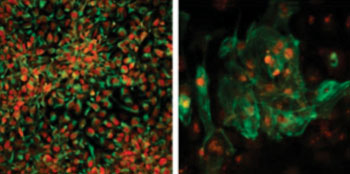Methods Developed to Generate Normal Stem Cells from Patients with Mitochondrial Defects
By LabMedica International staff writers
Posted on 30 Jul 2015
A recent paper described two methods for converting cells from patients with mitochondrial defects into normal pluripotent stem cells that could be induced to differentiate into several different types of tissues.Posted on 30 Jul 2015
Mutations in mitochondrial DNA (mtDNA) can cause fatal or severely debilitating disorders with limited treatment options. Clinical manifestations vary based on mutation type and the relative levels of mutant and normal mtDNA within each cell.

Image: Researchers have generated disease-free stem cells from patients with mitochondrial disease that can be converted into any cell type including neuronal progenitors (left) or heart cells (right). These could potentially be used for future transplantation into patients (Photo courtesy of Salk Institute of Biological Studies).
Investigators at the Salk Institute for Biological Studies (La Jolla, CA, USA) first described the situation of patients having both normal and mutated mtDNA. Skin cells from these patients could be turned into a population of stem cells, some with normal mtDNA and some with mutated mtDNA. It was then a simple matter to clone only the cells with normal mtDNA to form a population of normal pluripotent stem cells.
The other case centered on patients with few, if any cells with normal mtDNA. To solve this problem the investigators removed the nuclei of the patient's skin cells, which contain most of their genes, and transplanted them into donor egg cells with healthy mitochondria. The new egg cells were then used to generate healthy pluripotent stem cells.
Results published in the July 15, 2015, online edition of the journal Nature revealed that both reprogramming approaches offered complementary strategies for derivation of pluripotent stem cells containing exclusively normal mtDNA.
"Right now, there are no cures for mitochondrial diseases," said senior author Dr. Juan Carlos Izpisua Belmonte, professor of genetics at the Salk Institute. "Very recently, we have developed ways to prevent these diseases, so it was natural to next ask how we could treat them."
Related Links:
Salk Institute













